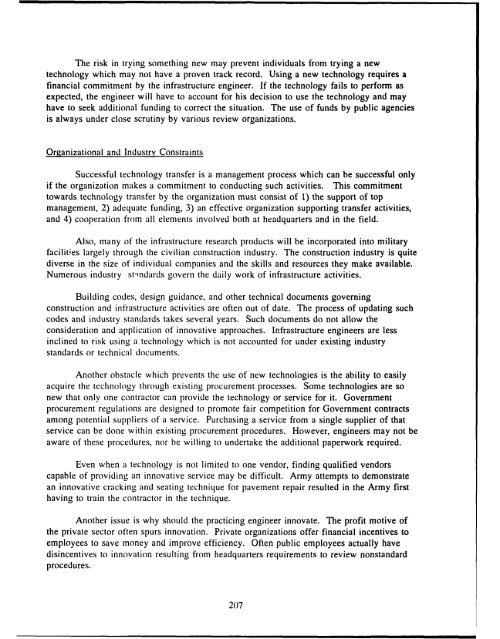Challenges and Opportunities for Innovation in the Public Works ...
Challenges and Opportunities for Innovation in the Public Works ...
Challenges and Opportunities for Innovation in the Public Works ...
Create successful ePaper yourself
Turn your PDF publications into a flip-book with our unique Google optimized e-Paper software.
The risk <strong>in</strong> try<strong>in</strong>g someth<strong>in</strong>g new may prevent <strong>in</strong>dividuals from try<strong>in</strong>g a new<br />
technology which may not have a proven track record. Us<strong>in</strong>g a new technology requires a<br />
f<strong>in</strong>ancial commitment by <strong>the</strong> <strong>in</strong>frastructure eng<strong>in</strong>eer. If <strong>the</strong> technology fails to per<strong>for</strong>m as<br />
expected, <strong>the</strong> eng<strong>in</strong>eer will have to account <strong>for</strong> his decision to use <strong>the</strong> technology <strong>and</strong> may<br />
have to seek additional fund<strong>in</strong>g to correct <strong>the</strong> situation. The use of funds by public agencies<br />
is always under close scrut<strong>in</strong>y by various review organizations.<br />
Organizational <strong>and</strong> Industry Constra<strong>in</strong>ts<br />
Successful technology transfer is a management process which can be successful only<br />
if <strong>the</strong> organization makes a commitment to conduct<strong>in</strong>g such activities. This commitment<br />
towards technology transfer by <strong>the</strong> organization must consist of 1) <strong>the</strong> support of top<br />
management, 2) adequate fund<strong>in</strong>g, 3) an effective organization support<strong>in</strong>g transfer activities,<br />
<strong>and</strong> 4) cooperation from all elements <strong>in</strong>volved both at headquarters <strong>and</strong> <strong>in</strong> <strong>the</strong> field.<br />
Also, many of <strong>the</strong> <strong>in</strong>frastructure research products will be <strong>in</strong>corporated <strong>in</strong>to military<br />
facilities largely through <strong>the</strong> civilian construction <strong>in</strong>dustry. The construction <strong>in</strong>dustry is quite<br />
diverse <strong>in</strong> <strong>the</strong> size of <strong>in</strong>dividual companies <strong>and</strong> <strong>the</strong> skills <strong>and</strong> resources <strong>the</strong>y make available.<br />
Numerous <strong>in</strong>dustry st<strong>in</strong>dards govern <strong>the</strong> daily work of <strong>in</strong>frastructure activities.<br />
Build<strong>in</strong>g codes, design guidance, <strong>and</strong> o<strong>the</strong>r technical documents govern<strong>in</strong>g<br />
construction <strong>and</strong> <strong>in</strong>frastructure activities are often out of date. The process of updat<strong>in</strong>g such<br />
codes <strong>and</strong> <strong>in</strong>dustry st<strong>and</strong>ards takes several years. Such documents do not allow <strong>the</strong><br />
consideration <strong>and</strong> application of <strong>in</strong>novative approaches. Infrastructure eng<strong>in</strong>eers are less<br />
<strong>in</strong>cl<strong>in</strong>ed to risk us<strong>in</strong>g a technology which is not accounted <strong>for</strong> under exist<strong>in</strong>g <strong>in</strong>dustry<br />
st<strong>and</strong>ards or technical documents.<br />
Ano<strong>the</strong>r obstacle which prevents <strong>the</strong> use of new technologies is <strong>the</strong> ability to easily<br />
acquire <strong>the</strong> technology through exist<strong>in</strong>g procurement processes. Some technologies are so<br />
new that only one contractor can provide <strong>the</strong> technology or service <strong>for</strong> it. Government<br />
procurement regulations are designed to promote fair competition <strong>for</strong> Government contracts<br />
among potential suppliers of a service. Purchas<strong>in</strong>g a service from a s<strong>in</strong>gle supplier of that<br />
service can be done with<strong>in</strong> exist<strong>in</strong>g procurement procedures. However, eng<strong>in</strong>eers may not be<br />
aware of <strong>the</strong>se procedures, nor be will<strong>in</strong>g to undertake <strong>the</strong> additional paperwork required.<br />
Even when a technology is not limited to one vendor, f<strong>in</strong>d<strong>in</strong>g qualified vendors<br />
capable of provid<strong>in</strong>g an <strong>in</strong>novative service may be difficult. Army attempts to demonstrate<br />
an <strong>in</strong>novative crack<strong>in</strong>g <strong>and</strong> seat<strong>in</strong>g technique <strong>for</strong> pavement repair resulted <strong>in</strong> <strong>the</strong> Army first<br />
hav<strong>in</strong>g to tra<strong>in</strong> <strong>the</strong> contractor <strong>in</strong> <strong>the</strong> technique.<br />
Ano<strong>the</strong>r issue is why should <strong>the</strong> practic<strong>in</strong>g eng<strong>in</strong>eer <strong>in</strong>novate. The profit motive of<br />
<strong>the</strong> private sector often spurs <strong>in</strong>novation. Private organizations offer f<strong>in</strong>ancial <strong>in</strong>centives to<br />
employees to save money <strong>and</strong> improve efficiency. Often public employees actually have<br />
dis<strong>in</strong>centives to <strong>in</strong>novation result<strong>in</strong>g from headquarters requirements to review nonst<strong>and</strong>ard<br />
procedures.<br />
207







